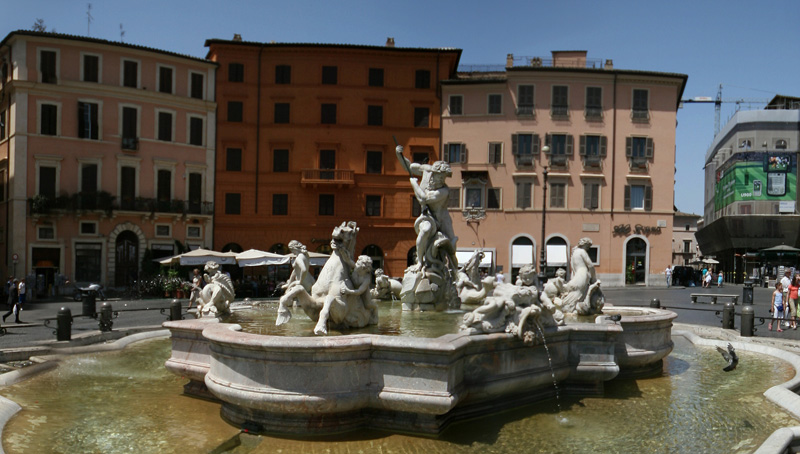
This photo of the Fountain of Neptune is part of one of the panoramic images found on the PanoramicEarth.com Tour of Rome. There are over 100 images taken from around Rome linked to an interactive map.
This image is of The Fountain of the Neptune found at the north end of Piazza Navona in Rome. The backdrop of coloured buildings just enhances the setting. Both this and the Fontana del Moro (Fountain of the Moors) at the other end of the piazza were designed by Giacomo della Porta in 1574. It is made or Portasanta, a special rose marble that has also been used in parts of St.Peter’s Basilica – notably the door jambs.
The original plan was to set the fountain with tritons and large masks, but the project was never completed and the fountain, un-named at the time, became known after the tradesmen working in the area – Fontana dei Calderai (Fountain of Coppersmiths / Biolermakers). Thus it remained for about 300 years.
In 1878, after the unification of Italy, the statue of Neptune slaying a giant octopus was added by Antonio Della Bitta, and the group of 8 sea figures playing in the basin by Gregorio Zappalà. The nymphs are set in pairs with two cherubs, two dolphins, two sea horses, and two sea nymphs or Nereids. At this time the fountain was renaimed Fountain of Neptune.
Piazza Navona was built originally as a 30,000 seater stadium by Domitian, and the square still holds it’s original shape. Most people enter near the central point, and are welcomed by the Fontana dei Quattro Fiumi or 'Fountain of the Four Rivers'. The ends of the square are much quieter places, with art stalls stationed around, though the authenticity of some of the works on display here may be questionable. Standing by the Fountain of Neptune gives a clear impression of the size of the square with the obelisk of the Fontana di Quattro Fiumi in the middle.
A full panoramic image showing the north end of Piazza Navona is found on the Rome tour by PanoramicEarth.com. An enlargement of this photo can be found on Flickr.
For more articles on Rome see the Rome Index or select one of the labels at the bottom.

No comments:
Post a Comment